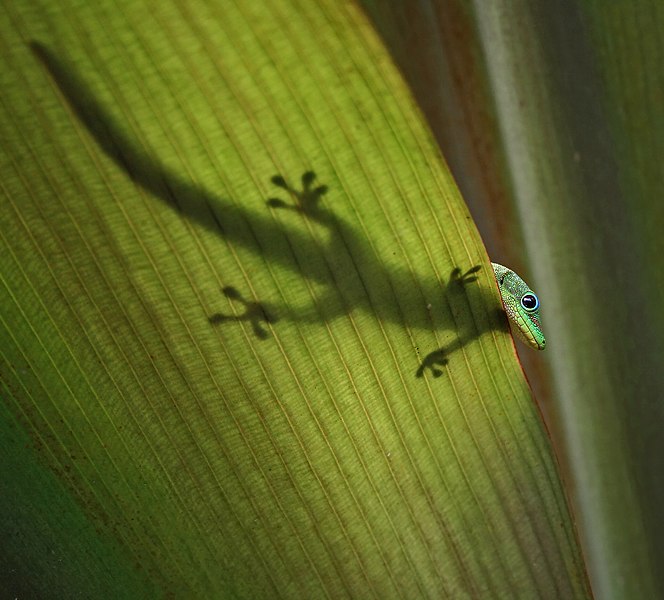 In Part 1 of this article I introduced Hagen’s new Smart Plants, an exciting line of realistic artificial plants (Bromeliads and Scindapsis) that contain small water-holding pools at their bases. When properly positioned in a terrarium, they provide naturalistic sites into which female Poison Frogs can deposit their tadpoles. Today we’ll see how other amphibians and reptiles can make use of this new and much-needed innovation.
In Part 1 of this article I introduced Hagen’s new Smart Plants, an exciting line of realistic artificial plants (Bromeliads and Scindapsis) that contain small water-holding pools at their bases. When properly positioned in a terrarium, they provide naturalistic sites into which female Poison Frogs can deposit their tadpoles. Today we’ll see how other amphibians and reptiles can make use of this new and much-needed innovation.
Arboreal Reptiles
In the wild, most highly arboreal snakes and lizards find all the water they need without ever setting foot or belly on the ground. Captives, especially high-strung or wild caught individuals, may be stressed if forced to do so.
Red-Tailed Ratsnakes and some Taiwan Beauty Snakes that I kept in large zoo exhibits rarely left the tree branches for water, but readily accepted bowls fastened to branches. Emerald Tree Boas, Green Tree Pythons and other tree specialists also prefer to drink while perched above the ground. One Scrub Python that I cared for was so “stubborn” about leaving her perch that I was forced to inject water into a dead rat offered on a long-handled tong.
The pools within Hagen’s Bromeliads should serve well as above-ground water bowls, and could also be used to provide nectar to Anoles, Day Geckos, New Caledonian Giant Geckos and similar lizards.
Amphibians, Tarantulas and Others
Arboreal Salamanders (Bolitoglossa ssp.) are troublesome captives, and do best in rather arid terrariums provisioned with watery retreats among the branches. Wild specimens of several species are most commonly encountered hiding within Bromeliads.
I had serious problems maintaining confiscated Arboreal Salamanders in the past, mainly due to their unique habitat requirements (they dehydrate easily, but tend to shed their tails if over-watered). I had some success using live Bromeliads, but would perhaps have fared better had artificial ones been available as well.
Bromeliad leaves and pools are also the preferred retreats of a great many arboreal frogs, including Red-Eyed and Cuban Treefrogs. Pink-Toed and other tree-dwelling Tarantulas, along with some snails, mantids and other invertebrates, may also put artificial Bromeliad pools to good use.
Crowded Ponds in the Treetops

Spiders that dive into minute pools to catch mosquito larvae, crabs that never descend to earth, tadpoles that are fed eggs by their mothers, salamanders observed nowhere else – the list of Bromeliad-dependent creatures is endless, and can provide a lifetime of interest to those who wish to study and keep them.
Further Reading
Pineapple Dreams: interesting article about the unique adaptations of animals found among Bromeliads.
Gold Dust Day Gecko image referenced from wikipedia and originally posted by Mila Zinkova
 That Reptile Blog – Reptile, Amphibian and Exotic Pet Care and Information
That Reptile Blog – Reptile, Amphibian and Exotic Pet Care and Information



I like those artificial plants – what a fantastic idea.
Hello Dave, Frank Indiviglio here.
Thanks for your interest in our blog and your opinion. I agree, and believe they will prove very useful in keeping and perhaps breeding a number of creatures.
Good luck, enjoy and please let me know if I can be of further assistance.
Best regards, Frank Indiviglio.
Hello Frank,
Have you worked with amphisbaenians at all? I’ve seen them available a few times and they seem like neat animals. However-I’m guessing not much success has been had in captivity with long term keeping/breeding?
Thanks!
~Joseph
Hello Joseph, Frank Indiviglio here.
Nice to hear from you…worm lizards, as they are sometimes called, have always been on my wish list but unfortunately, except for examining a few that showed up more-or-less by accident, I’ve not had much of a chance to work with them.
Please let me know if you decide to give them a try, I’d love to hear more and can search around for contacts for you. Good luck, enjoy and please keep me posted.
Best regards, Frank Indiviglio.
I have two Australian green treefrogs that I bought in a pet store. One is male, the other is female, the male is chirping his mating call, they are very affectionate with one another and I am sure they will mate. If and when they lay their eggs; from what I recall tree frogs lay their eggs on a leaf in a tree and when the tadpoles hatch they fall into a pool of water to grow, My question is how do I simulate this effect successfully?
Hello Tyler, Frank Indiviglio here.
Thanks for your interest in our blog.
Some treefrogs do deposit eggs over water. However, I’m guessing that your treefrogs are White’s Treefrogs (Litoria caerulea)? These lay in water in typical frog fashion. Please check my 2 Part article Breeding White’s Treefrogs for information on how to set them up and raise the tadpoles. Since the male is already calling, you do not need to worry about the information on cooling them down before breeding. A rain chamber may help, but start by just setting them up in a breeding tank as described in the article and see what happens.
Please let me know if you need any further information. Good luck, enjoy and please keep me posted.
Best regards, Frank Indiviglio.